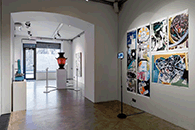Ruby Red Falls 1
Ruby Red Falls 2
Installation
Getty PST / No Prior Art
Los Angeles Central Library
Installation
Conversation at a Nuclear Plant 2
National Arts Club, NYC
Installation
Marina Gisich Gallelry
St. Petersburg, Russia
Detail
ExtrActivism
WUK, Vienna, Austria



























